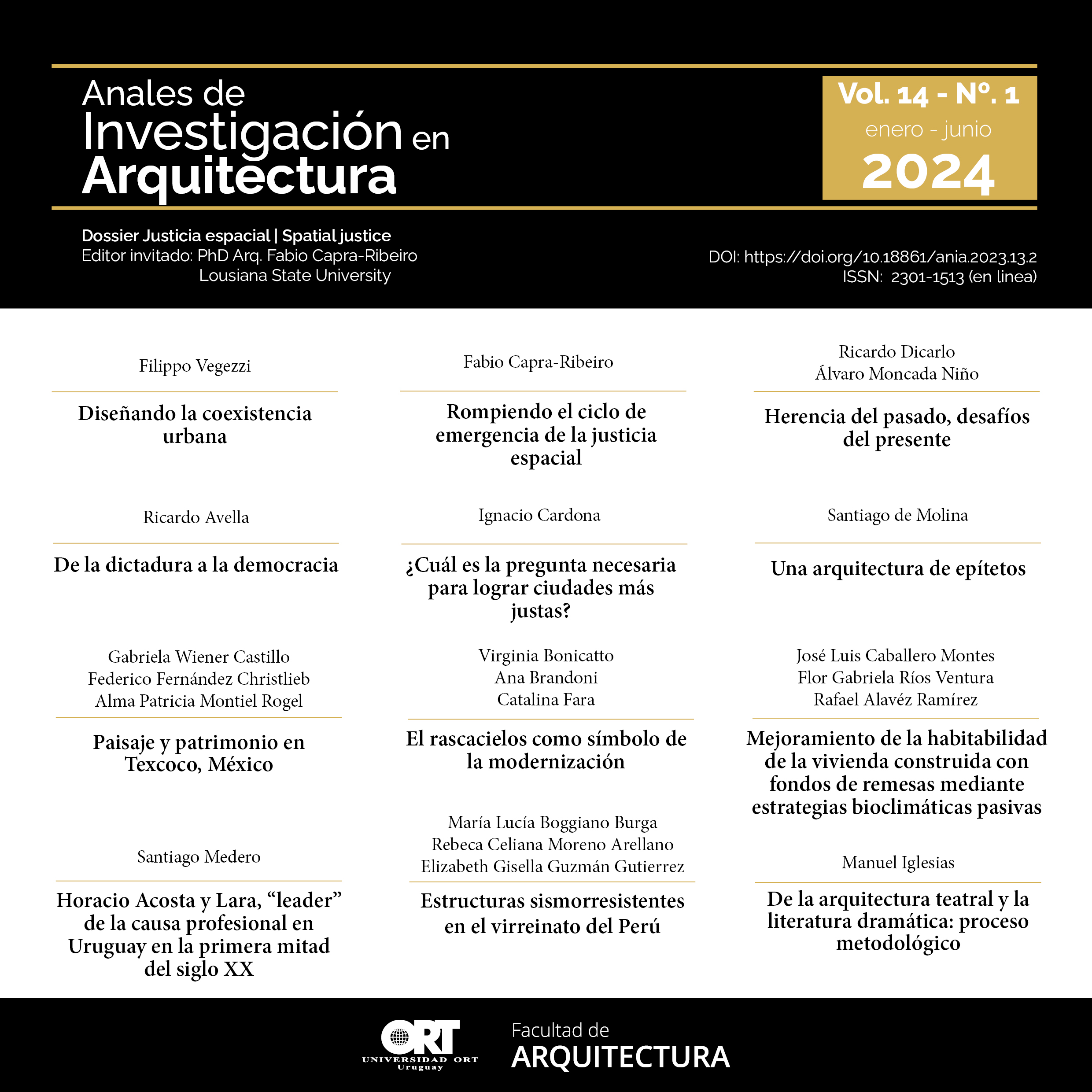Confluence of social perception and environmental habitability in public spaces of indigenous communities of the Manantlán Reserve, Jalisco, Mexico
DOI:
https://doi.org/10.18861/ania.2024.14.1.3426Keywords:
Confluence, social perception, mutual interaction, public space, weather conditions, habitability, protected natural area, indigenous communities, ecosystem, traditions and customsAbstract
The social perception and environmental habitability that occurs in the public spaces of indigenous communities of the Sierra de Manantlán, Jalisco, Mexico; they refer to a sense of balance regarding the emotional and physical conditions of its inhabitants. Its social, political, cultural and customs organization mark a unique identity in its communal life. The social perception as a factor of regulation of their way of working, contributes to an efficient and supportive performance towards their own, care and respect towards the ecosystem and an organized mass intervention. The objective of the work was to evaluate the conditions of social perception and environmental habitability of inhabitants in the public spaces of of Ayotitlán and Cuzalapa, Jalisco. The project refers to the mutual interaction between inhabitants of the analyzed communities, for this, interviews were carried out with key actors of the localities and information cards were applied to users on social perception and environmental habitability. Likewise, the measurement variables of the climatic conditions were carried out during the sampling stage of the cold period. Regarding the analysis of the research data, multiple linear regression was used for a Pearson association between the study variables, the meteorological and complementary variables of the applied sampling were examined. According to the results obtained, it is seen that climatic conditions affect the performance of productive activities in public spaces of the inhabitants of Ayotitlán and Cuzalapa, Jalisco, however; their social perception rooted in their beliefs and customs generates links of ecotourism and cultural dynamism, in this way; the study contributes with the municipality of both locations to obtain accurate information regarding this item and can be used for the benefit of society.
Downloads
References
ASHRAE, A. (2020). Norma 55-2020, condiciones ambientales térmicas para la ocupación humana, Atlanta: sociedad americana de ingenieros de calefacción, refrigeración y aire acondicionado. Inc., Estados Unidos.
Benavides, R. (2011). Calidad de vida, calidad ambiental y sustentabilidad como conceptos urbanos complementarios. FERMENTUM Revista Venezolana de Sociología y Antropología, 176–207.
De la Federación, D. O. Norma Oficial Mexicana NOM-AA-62-1994. Acústica-determinación de los niveles de ruido ambiental.
De la Federación, D. O. Norma Oficial Mexicana NOM-015-STPS-2001. Condiciones térmicas elevadas o abatidas-condiciones de seguridad e higiene índice.
De la Federación, D. O. Norma Oficial Mexicana NOM-013-ENER-2013, Eficiencia energética para sistemas de alumbrado en vialidades.
De la Federación, D. O. Norma Oficial Mexicana NMX-AA-166/1-SCFI-2013. Estaciones meteorológicas, climatológicas e hidrológicas - parte 1: Especificaciones técnicas que deben cumplir los materiales e instrumentos de medición de las estaciones meteorológicas automáticas y convencionales.
del Campo Saray, F. J. M., Anguiano, R. V., Morales, G. B., y Gómez, C. G. (2020). Desarrollo de índice de habitabilidad térmica en periodo frío para espacios públicos exteriores. Revista de Ciencias Tecnológicas, 3(3), 145-172.
García Doménech, S. (2013). Percepción social y estética del espacio público urbano en la sociedad contemporánea.
Gerritsen, P. R. W. (2014). Working with Indigenous women on multifunctionality and sustainable rural tourism in western Mexico. The Journal of Rural and Community Development, 9(3), 243–-257.
Gómez Cárdenas, C. S., y Orellana Armijos, F. S. (2021). Áreas verdes y su relación con la habitabilidad urbana. Caso de estudio: cabecera urbano parroquial de Sinincay (Bachelor's thesis, Universidad del Azuay).
González Reyes, G. (2013). Señorío, pueblos y comunidades. La organización político territorial en torno del Chicnahuitecatl, siglos XV-XVIII. Universidad Autónoma del Estado de México.
INEGI (2018) https://inegi.org.mx
Instruments, E. (2019). Extech. Manual de Usuario. Selección, p. 1-144.
ISO, E. (2006). 7730, Ergonomía del ambiente térmico. Determinación analítica e interpretación del bienestar térmico mediante el cálculo de los índices PMV y PPD y los criterios de bienestar térmico local. Madrid: ES. Asociación Española de Normalización y Certificación (AENOR).
ISO 9060: 2018 (2018). Solar Energy. Specification and classifications of instruments for measuring hemispherical solar and direct solar radiation.
Maldonado-Zapata, J. A. (2018). Meteorología y percepción social. Acta de las Jornadas Científicas de la Asociación Meteorológica Española, (32).
Mues, A. (2011). Habitabilidad y Desarrollo Urbano Sostenible. 136. http://infonavit.janium.com/janium/Documentos/035079.pdf
Normas técnicas hidrográficas (2013). Manual de procedimientos para la medición y procesamiento del viento en superficie. HIDRONAV-5171 1ª. edición, p. 1-22.
Nº, O. M. M. (2014). Guía de Instrumentos Meteorológicos y Métodos de Observación.
Organización Internacional de Normalización. (2019). ISO 10551: 2019. Ergonomía del ambiente térmico - Evaluación de la influencia del ambiente térmico utilizando escalas de juicio subjetivo.
Ortega-Carbajal, M. F., Hernández-Mosqueda, J. S., & Tobón-Tobón, S. (2015). Análisis documental de la gestión del conocimiento mediante la cartografía conceptual. Ra Ximhai, 11(4), 141-160.
Página de internet disponible en: https://www.pce-instruments.com/ [fecha de Consulta 28 de mayo de 2020].
Página de internet disponible en: https://www.amazon.com/-/es/meteorol%C3%B3gica-interiores-exteriores-temperatura-inal%C3%A1mbrica/dp/B08S59R9HJ [fecha de Consulta 04 de diciembre de 2021].
Página de internet disponible en: https://www.solerpalau.com/es-es/blog/indice-calidad-aire/ [fecha de Consulta 28 de mayo de 2020].
Robertson Sierra, M. La casa de nuestra cultura. El territorio de los nahuas de Ayotitlán, Chiapas, núm. 8, México: IIEc, UNAM-Ediciones ERA, 1999, pp. 93-102. ISBN: 968-411-465-6.
Sobrino, J. (2015). Medición y determinantes de la pobreza en las principales ciudades de México. La situación demográfica en México 2015.
Tetreault, D. V., y Lucio López, C. F. (2011). Diversidad biocultural en el estado de Jalisco: Pueblos indígenas y regiones de alto valor biológico. Espiral (Guadalajara), 18(51), 165-199.
Downloads
Published
How to Cite
Issue
Section
License
Copyright (c) 2023 Francisco José Martín del Campo Saray, Gonzalo Bojórquez Morales, Peter R.W. Gerritsen

This work is licensed under a Creative Commons Attribution 4.0 International License.
The journal and its contents are licensed under the Creative Commons - Attribution 4.0 International License (CC BY 4.0). It is possible to copy, communicate and publicly distribute its content as long as the individual authors and the name of this publication are cited, as well as the publishing institution (Universidad ORT Uruguay).


